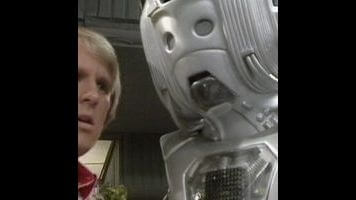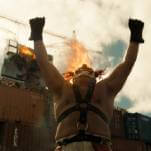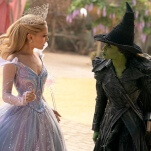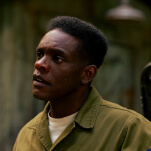“The Invasion” (season 6, episodes 15-19; originally aired Nov. 2-Dec. 21, 1968)
There is a void at the heart of “The Invasion” that wasn’t completely apparent to me while watching the first half of the story last week. I’m talking about the story’s marquee villains, of course: The Cybermen, who are absent for basically the entire first four episodes of this particularly epic-length serial, turn out in the second half to be a squadron of robot MacGuffins, and not actually the story’s real antagonists. As I should have realized (especially since I’ve seen the story a couple of times before, though not for several years), “The Invasion” is really a story about Tobias Vaughn, the man who arrogantly and hubristically makes a devil’s bargain with a force he ultimately cannot control—and on the other side of the coin, it’s a groundwork-laying introduction to the UNIT era. With only minor rewriting, the Cybermen could have been replaced by any number of invading alien forces—in fact, that’s basically what happens in the next UNIT story, “Spearhead From Space.”
Alfred Hitchcock, you might remember, coined the term “MacGuffin” to refer to an element in a story that catalyzes the characters into action but isn’t necessarily an active part of the plot itself. Usually, it’s an object, like the letters of transit in Casablanca. But the Cybermen are so reactive in this story that I think they qualify as well.
The reason I forgot how little “The Invasion” is about the Cybermen, of course, is that what little screen time they do get includes several of the most iconic moments they have in the whole of Doctor Who. They have their moments here, but they are literally just moments—brief scenes that became part of the visual lore of the Cybermen across the show’s history. Some of these were themselves callbacks to earlier appearances—the awakened Cyberman bursting out of its metal container evokes a similar scene in “Tomb Of The Cybermen,” as does the moment when one of them grabs Jamie’s ankle as he climbs up from the sewer tunnels.
But let’s look at what’s unquestionably the most well-known shot from “The Invasion,” the cliffhanger moment in episode six when they burst forth from London’s underground and are seen swarming through the city streets, including an appearance in front of one of the city’s most famous landmarks, St. Paul’s Cathedral. It’s a classic example of the reliable sci-fi motif of the unearthly and strange asserting dominance over the earthly and familiar, with the frisson of a real location that the audience knows well granting the scene extra punch. (H.G. Wells pioneered the technique in the novel War Of The Worlds, which is full of vividly descriptive passages about the Martians wreaking havoc not simply “in London,” but in specifically named streets and neighborhoods. A similar approach to verisimilitude also spawned the infamous accidental hoax of Orson Welles’ War Of The Worlds radio drama.) It wasn’t a new thing for Who, which had placed central London under threat in “The Dalek Invasion Of Earth,” “The War Machines,” and “The Web Of Fear.” “Dalek Invasion,” which I’ll be covering in about a month, was a more thorough look than “The Invasion” at what an alien occupation might actually be like—the Doctor arrives after the Daleks have taken over, and sees the kind of government they’ve set up. A slightly disguised what-if-the-Nazis-had-won story, it’s like an early version of V.
“The Invasion,” though, has far less grandiose aims—the invasion itself is unsuccessful, after all. Iconic as it is, the St. Paul’s shot is little more than striking a pose, when all is said and done, even if they do knock everyone on Earth unconscious. The Cybermen appear, and they look menacing when they appear, but we never really see them do anything menacing after they make their big stand. This is also a big reason “The Invasion” feels too long to me. (Originally planned as a six-parter, it was expanded to eight to cover problems with other serials being made the same season.) Which is not to say that I find it dull—just the opposite. The energy of the drama rarely flags, partly because the heroes are striving mightily to prevent the Cybermen from reaching a point where they can act, the implication being that if the Cybermen get the chance to make a serious move, the whole game is over. Taken as a whole, the Cybermen behave more like the force of nature in a disaster film, like a hurricane or an earthquake, than an invading army. They’re there so that the heroes, who are shown in much sharper focus, have something to act against.
Still, the St. Paul’s sequence is remembered for good reason, because it takes the time it needs to do the job of building and releasing tension. It starts by foregrounding the peaceful quiet of the ordinary day—birds chirp, the streets are calm, and Isobel and her soldier boyfriend (ordinary Londoners, that is, not the Doctor) chat about the possibility that maybe nothing bad is actually going to happen. It’s the calm before the storm. But of course the viewers are increasingly aware, consciously or not, that something is about to happen—and since we already know who the villains are by now, we’re expecting a more-than-usually impressive full-scale introduction. (Watching it with me at home, my wife started singing her own version of The Monkees’ theme song at this point: “Hey hey, we’re the Cybermen, and people say we cyber around…”) Then, suddenly, there’s the eerie noise of the hypnotic weapon, but for more than a minute of screen time—quite a time investment—we don’t get to see what’s making it, only the reactions of the baffled, horrified human characters, who slump to the ground. As an extra shock, the Doctor’s precautions fail him, and he also collapses. Then, and only then, do the Cybermen appear—apparently triumphant, so tune in next week.
But for all the talk about hundreds of Cybermen marching through the streets, they’re still barely in “The Invasion.” I don’t think they get more than 10 lines of dialogue to share between them—and their leader and official mouthpiece is a faceless and nearly motionless device designed especially to hide the fact that the Cybermen are even in this show. This might have been done partly to avoid overusing them, because they were in serious danger of getting stale—this was their fifth appearance in three years, and they’d never appear on the show so often again. Here in this final story, they’re little more than drones. It’s pretty clear that the weight of the story, both in terms of plot mechanics and the charismatic evil needed in a story’s true focal-point villain, rests on what Vaughn wants, not what the Cybermen want.
The Doctor also takes Vaughn far more seriously than he takes the Cybermen, or maybe it’s just that he’s decided that there’s no point in even talking to them. When he makes his last-ditch attempt to negotiate for peace, he heads for Vaughn—communicating with the Cybermen is never even brought up as an option. Later, when he’s in Vaughn’s office with the Cyber-Planner right in front of him, he still speaks only to Vaughn. There’s no negotiations, no barbed witticisms, no stalling for time while he tries to figure out their plan. They’re beneath his notice. It’s missiles for the Cybermen. Talk is reserved for Vaughn.
It turns out the invasion wasn’t even their idea, but Vaughn’s:
“Oh, I’ve planned this operation in great detail, allowing for every possible factor. It was I who contacted them in deep space, provided the means by which they travelled to Earth. I masterminded the whole operation from A to Z. They have merely provided their advanced scientific skills, their might and strength.”
Technically, since the earlier Cybermen stories took place in the future and “The Invasion” is set basically in the present, this is the Cybermen’s first encounter with Earth—and Vaughn seems to be suggesting that he’s the one who made them aware Earth even existed. If not for Vaughn, they might not have bothered trying to destroy humanity at all. Their presence is this story is almost entirely reactive, merely responding to Vaughn’s offer to help them invade Earth, then responding again when the other humans offer resistance. Vaughn drives everything that happens in the story, and his ultimate goal is, basically, that of a fascist/Objectivist James Bond villain: “You think I’m mad, that all I want is power for its own sake. No, I have to have power. The world is weak, vulnerable, a mess of uncoordinated and impossible ideals. It needs a strong man, a single mind. A leader!”
He sees the Cybermen as merely a catalyst for his own plans, and until the Cyber-Planner literally goes for the nuclear option, he appears to have the Cybermen completely outmaneuvered. He’s even beaten them at their own most distinctive game: The most chilling aspect of the Cybermen is that they want to erase our humanity and make us into them, but Vaughn is exultantly still Vaughn, arrogant and emotional, even with a cybernetic body. It’s like being bitten by Dracula and avoiding the whole thing about sunlight, crosses, and garlic. In his pride, he thinks he’s already won. But he is too arrogant to realize that he’s not as in charge as he’d like to be.
The arrival of the Doctor has given him the final element of his plan, since without the elements from the TARDIS he couldn’t have had Professor Watkins build his cerebration mentor—i.e. the freaking-out-robots box. But the Doctor is an agent of chaos more potent than Vaughn can plan for, and his influence throws the balance of power all out of whack, catching Vaughn between the Cybermen and the Doctor. When his scheme unravels, he is forced to switch sides. He doesn’t really have much choice—his plan to betray the Cybermen is loused up when they betray him first, and decide to retaliate against the Zoe-masterminded, unexpectedly devastating missile attack by wiping out all life on Earth. (This would also eliminate humanity as a source of potential future Cybermen, but maybe by their logic, the threat is greater than the opportunity.)
Vaughn's caught-in-the-middle status is captured visually in a pair of shots in episodes six and seven—in the first one, he's shown on the left side of the screen in a medium shot while the glowing Cyber-Director looms in extreme closeup on the right. That's reversed in the next episode as Vaughn is dwarfed instead by the Doctor looming over him from the left. (Sadly, the impact is wrecked a little bit by Stoney standing a bit too far to one side and getting obscured by Troughton.)
Besides the length issues, there’s a tendency in this story to cut corners, sometimes forgivably and sometimes not. It’s understandable, if disappointing, that the show’s budget only allowed them to make six Cybermen costumes, so that we can only be told, not shown, that there are hundreds of Cybermen walking around London. It’s the bargain you have to make with a lot of older sci-fi, not just Who—sometimes your imagination has to fill in the gaps where the technical capabilities of the era’s filmmaking failed. But that shouldn’t apply to other kinds of obvious gaps in the narrative, and so it’s a little more difficult to accept that Professor Watkins’ rescue takes place offscreen, in between one scene announcing that UNIT plans to rescue him, and another where Packer tearfully tells Vaughn how they did so. It’s a jarring omission, even allowing for the difficulties of making low-budget TV in 1968. But if things are a little undercooked sometimes, the characters and the action keep “The Invasion” watchable. Director Douglas Camfield was one of the show’s best crafters of action and tension. Any scene with Vaughn yelling at out-of-his-depth lackey Packer is great fun. Troughton is his usual commanding self, and his improvised comic bit in the tunnels—flipping a coin to decide which way to go, looking resolutely in the direction that “won,” and just as resolutely walking the other way—is pure gold.
But it’s worth giving special mention to Wendy Padbury’s Zoe, who shines throughout the story and particularly in her big scene in the sixth episode, saving the day through the power of math. Who has tried variations on the slightly offbeat girl-genius character several times, from Susan, the very first companion, to Romana and Nyssa, but I don’t think they ever hit the target better than Zoe: She’s perky and energetic without being annoying, and smart without being condescending. While the Doctor grouses irritably about how he can’t stand computers, Zoe steps up with glee to demolish them, melting the logic circuits of Vaughn’s robo-secretary and later knocking out the invasion fleet with some on-the-fly missile-trajectory recalculations. (It’s also amusing to watch the male extras in that scene sneaking glances at her shape-conscious catsuit as she walks by. )
Lastly, I don’t want to neglect to mention the fifth episode’s terrific bit of surreal nightmare material, the Cyberman that can’t stop screaming. Driven insane by an excess of fear from Vaughn’s emotion machine, it’s then just dumped into the sewer tunnels to wander and howl, equally pathetic and terrifying. It’s a monster, but a poor, damaged, utterly freaked-out monster stumbling hopelessly through the dark and apparently ready to attack and kill anything it sees. It’s an image that’s stuck with me for many years. Seeing it again, I couldn’t help noticing that it doesn’t try to kill anything it sees—interestingly, it ignores the humans Jamie, Zoe and Isobel and goes after its fellow Cybermen instead. It’s hard to say whether it was attacking them or asking for help, considering it’s swiftly killed by a UNIT grenade. But I lean toward the “attack” idea, consistent with the idea expressed in other Who stories that the Cybermen are conscious on some level of what terrible monstrosities they have been turned into, and that the robotic parts of their brains are ruthlessly clamping down on that horror. I suppose that this is the only real explanation for why Vaughn’s emotion machine is so effective, for that matter. Because it’s not merely something like a logical paradox that trips them up. It’s that they are forced to feel, and they’re apparently on such a hair trigger that the Cybermen can be destroyed merely by forcing them to realize that they are Cybermen. Which is a hell of an Achilles heel, really. Essentially, by turning his machine on them, Vaughn makes the Cybermen collapse in a helpless panic at the mess they’ve made of their personal lives. God forbid he ever turns that thing on me.
Stray observations:
• Doctor Who was often pretty brazen about lifting plot elements straight out of earlier stories, and a good chunk of “The Invasion,” particularly the use of brainwashing to control high-profile leaders, comes from the 1950s sci-fi TV miniseries Quatermass II.
• Since there’ll be plenty of opportunity to write about him later, including next week, I’ll table discussion of Nicholas Courtney’s early appearance here as Brigadier Lethbridge-Stewart except to say that he clearly had the character nailed right from the beginning. If you’re a new-Who fan unfamiliar with the Brig, he’s the guy mentioned in the latest season finale when the Doctor gets a phone call telling him an old friend has died—as did Courtney, earlier this year.
• Next time: The Third Doctor meets Jo Grant, and the Master unleashes the first of many evil schemes in “Terror Of the Autons.”
• Oct. 23: “The Talons Of Weng-Chiang”
• Oct. 30: “Kinda”
• Nov. 6: “The Dalek Invasion of Earth”
• Nov. 13: “The War Games,” episodes 1-5
• Nov. 20: “The War Games,” episodes 6-10
• And coming up after that, “The Silurians,” “City Of Death,” and visits to the Fifth, Sixth, and Seventh Doctor eras in episodes to be named later.







































